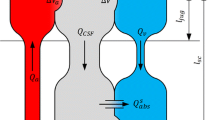Abstract
The effects of compression of the internal jugular veins and the inferior vena cava are simulated using an equivalent electronic circuit, which included simulation of cardiocirculatory phenomena and special features of the cerebral circulation. Compression of the inferior vena cava resulted in a profound decrease in cardiac output (from 4.5 to 1.5l min−1) and arterial pressure (from 140/85 to 50/35 mm Hg). Compression of the internal jugular veins resulted in a negligible slightly decreased. Cerebral capillary and internal jugular pressures were considerably increased, leading to obstruction of cerebral veins and increased pressure (from 9 to 22 mm Hg) and volume (from 120 to 145 ml) of the cerebrospinal fluid (CSF). Increased cerebral capsule compliance resulted in decreased CSF pressure (from 9 to 8.5 mm Hg), but CSF volume increased (from 120 to 190 ml). A small increase in brain volume (from 1000 ml to 1060 ml, 6% volume increase) was compensated for by an equal decrease in the volume of CSF. When brain volume was above 1080 ml, the absorption of CSF was reduced, and its pressure increased.
Similar content being viewed by others
References
Bejjani, G. K., Sullivan, B., Salas-Lopez, E., Abello, J., Wright, D. C., Jurjus, A., andSekhar, L. (1998): ‘Surgical anatomy of the infratemporal fossa: The styloid diaphragm revisited’,Neurosurgery,43, pp. 842–853
Coplin, W. M., O'Keefe, G. E., Grady, M. S., Grant, G. A., March, K. S., Winn, H. R., andLam, A. M. (1997): ‘Thrombotic, infectious and procedural complications of the jugular bulb catheter in the intensive care unit’,Neurosurgery,41, pp. 101–109
Czosynka, M., Kirkpatrick, P. J., andPickard, J. D. (1996): ‘Multimodal monitoring and assessment of cerebral haemodynamic reserve after severe head injury’,Cerebrovasc. Brain Metab. Rev.,8, pp. 237–295
Dolenc, V. V. (1989): ‘Anatomy and surgery of the cavernous sinus’ (Springer-Verlag Wien, New York, 1989)
Duke, B. J., Ryu, R. K., Brega, K. E., andColdwell, D. M. (1997): ‘Traumatic bilateral jugular vein thrombosis: Case report and review of the literature’,Neurosurgery,41, pp. 680–683
Gotoh, M., Ohmoto, T. andKuyama, H. (1993): ‘Experimental study of venous circulatory disturbance by dural sinus occlusion’,Acta Neurochir (Wien),124, pp. 120–126
Guyton, A. C., andHall, J. E. (1996): ‘Textbook of medical physiology’, 9th edn (W. B. Saunders, New York, 1996)
Kuether, T. A., O'Neill, O., Nesbit, G. M., andBarnwell, S. L. (1998): ‘Endovascular treatment of traumatic dural sinus thrombosis: Case report’,Neurosurgery,42, pp. 1163–1167
Piechnik, S. K., Czosnyka, M., Richards, H. K., Whitfield, P. C., andPickard, J. D. (2001): ‘Cerebral venous blood outflow: a theoretical model based on laboratory simulation’,Neurosurgery,49, pp. 1214–1223
Rupnik, M., Runovc, F., Sket, D., andKordas, M. (2002): ‘Cardiovascular physiology: simulation of steady state and transient phenomena by using the equivalent electronic circuit’,Comput. Methods Programs Biomed.,67, pp. 1–12
Schaffranietz, L., Grothe, A., andOlthoff, D. (2000): ‘Use of the sitting position in neurosurgery. Results of a 1998 survey in Germany (in German)’,Anaesthesist,49, pp. 269–274
Schmid-Elsaesser, R., Steiger, H. J., Yousry, T. Seelos, K. C., andReulen, H. J. (1997): ‘Radical resection of meningeomas and arteriovenous fistulas involving critical sinus segments. Experience with intraoperative sinus pressure monitoring and elective sinus reconstruction in 10 patients’,Neurosurgery,41, pp. 1005–1008
Standefer, M., Bay, J. W., andTrusso, R. (1984): ‘The sitting position in neurosurgery. A retrospective analysis of 488 cases’,Neurosurgery,14, pp. 649–658
Stocchetti, N., Paparella, A., Bridelli, F., Bacchi, M., Piazza, P., andZuccoli, P. (1994): ‘Cerebral venous oxygen saturation studied with bilateral samples in the internal jugular veins’,Neurosurgery,34, pp. 38–43
Author information
Authors and Affiliations
Corresponding author
Rights and permissions
About this article
Cite this article
Bošnjak, R., Kordaš, M. Circulatory effects of internal jugular vein compression: A computer simulation study. Med. Biol. Eng. Comput. 40, 423–431 (2002). https://doi.org/10.1007/BF02345075
Received:
Accepted:
Issue Date:
DOI: https://doi.org/10.1007/BF02345075




